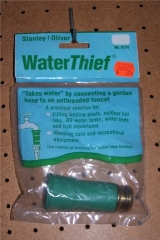
Water thief
Encyclopedia
This term refers to three devices: one ancient and two modern.
 1. A water thief is a rubber
1. A water thief is a rubber
fitting that attaches to an unthreaded faucet on one end and a common garden hose
on the other. It is commonly used to fill fresh water tank
s in recreational vehicle
s when a threaded hose bib is not available.
2. A water thief allows firefighters to break down one larger line into several smaller ones, each with independent control of water
flow at the valve
.
3. Another device, used in antiquity
, was called a "water thief," or clepsydra. Carl Sagan
describes it in Cosmos
, (Random House, 1980, pp.179-80):
"The experiment was performed in support of a totally erroneous theory of the circulation of the blood, but the idea of performing any experiment to probe Nature is the important innovation."

Rubber
Natural rubber, also called India rubber or caoutchouc, is an elastomer that was originally derived from latex, a milky colloid produced by some plants. The plants would be ‘tapped’, that is, an incision made into the bark of the tree and the sticky, milk colored latex sap collected and refined...
fitting that attaches to an unthreaded faucet on one end and a common garden hose
Garden hose
A garden hose is a flexible tube used to carry water. There are a number of common attachments available for the end of the hose, such as sprayers and sprinklers...
on the other. It is commonly used to fill fresh water tank
Water tank
A Water tank is a container for storing water. The need for a water tank is as old as civilized man, providing storage of water for drinking water, irrigation agriculture, fire suppression, agricultural farming, both for plants and livestock, chemical manufacturing, food preparation as well as many...
s in recreational vehicle
Recreational vehicle
Recreational vehicle or RV is, in North America, the usual term for a Motor vehicle or trailer equipped with living space and amenities found in a home.-Features:...
s when a threaded hose bib is not available.
2. A water thief allows firefighters to break down one larger line into several smaller ones, each with independent control of water
Water
Water is a chemical substance with the chemical formula H2O. A water molecule contains one oxygen and two hydrogen atoms connected by covalent bonds. Water is a liquid at ambient conditions, but it often co-exists on Earth with its solid state, ice, and gaseous state . Water also exists in a...
flow at the valve
Valve
A valve is a device that regulates, directs or controls the flow of a fluid by opening, closing, or partially obstructing various passageways. Valves are technically pipe fittings, but are usually discussed as a separate category...
.
3. Another device, used in antiquity
Classical antiquity
Classical antiquity is a broad term for a long period of cultural history centered on the Mediterranean Sea, comprising the interlocking civilizations of ancient Greece and ancient Rome, collectively known as the Greco-Roman world...
, was called a "water thief," or clepsydra. Carl Sagan
Carl Sagan
Carl Edward Sagan was an American astronomer, astrophysicist, cosmologist, author, science popularizer and science communicator in astronomy and natural sciences. He published more than 600 scientific papers and articles and was author, co-author or editor of more than 20 books...
describes it in Cosmos
Cosmos
In the general sense, a cosmos is an orderly or harmonious system. It originates from the Greek term κόσμος , meaning "order" or "ornament" and is antithetical to the concept of chaos. Today, the word is generally used as a synonym of the word Universe . The word cosmos originates from the same root...
, (Random House, 1980, pp.179-80):
"A brazen sphere with an open neck and small holes in the bottom, it is filled by immersing it in water. If you pull it out with the neck uncovered, the water pours out of the holes, making a small shower. But if you pull it out properly, with the neck covered, the water is retained in the sphere until you lift your thumb. If you try to fill it with the neck covered, nothing happens. Some material substance must be in the way of the water. We cannot see such a substance. What could it be? Empedocles argued that it could only be air. A thing we cannot see can still exert pressure, frustrate my wish to fill a vessel with water if I were dumb enough to leave my finger on the neck. Empedocles had discovered the invisible. Air, he thought, must be matter in a form too finely divided to be seen."
"The experiment was performed in support of a totally erroneous theory of the circulation of the blood, but the idea of performing any experiment to probe Nature is the important innovation."

